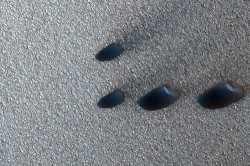[/caption]
As the Phoenix Mars lander will agree, it’s cold near Mars’ North Pole. Phoenix is currently seeing the winter frost encroach on its location, bright patches of ice appearing on the rocks surrounding it. Another sure sign of winter at this high latitude is the loss of light; soon day will turn to night, forcing Phoenix to enter a Sun-deprived coma. But as one Mars mission draws to a close, other missions continue their diligent watch over the planet 24/7. One such mission is NASA’s Mars Reconnaissance Orbiter (MRO), using its High Resolution Imaging Science Experiment (or HiRISE for short) to pick out the tiny surface features on the Red Planet from around 320 km (200 miles) above.
As winter sets in on the Martian northern hemisphere, HiRISE continues to capture some stunning images of the translucent icy surface…

It is thought that the bright areas of ice in the image above comes from surface frost deposited the previous year, but the polar temperatures remained so cold throughout the Martian summer that the frost didn’t sublimate into the thin atmosphere. So, the surface ice remained throughout the year, gradually undergoing physical changes, creating a polygonal texture when viewed from orbit. The texture was probably down to temperature variations, stressing and cracking the ice.
» See the full resolution region imaged by HiRISE (very long 512×12649px .jpg image)…
Looking at the detail of the sand dunes, it becomes apparent that the dunes are still active despite the icy surroundings. The streaks of loose sand appear to indicate a dominant southwesterly wind direction.
Source: HiRISE


Excellent!!!
The barchans as shown in the closeup image are very interesting, even beautiful. However, the full-view HiRISE strip is a pretty good candidate to be the most boring thing ever shown on the internet. It’s a matter of perspective, I guess.
‘Joel’-your comment is a pretty good candidate to be the most boring thing ever said on the internet. It’s a matter of perspective, I guess.
It looks weirdly smooth and flat between the ice dunes ! From my perspective, an excellent piccy !
No matter how much I stare at this photo it still looks like a close-up photo of bits of blue plastic in the sunlight on a white carpet. I just can’t get a grasp of the scale.
fantastic!
there ARE sand dunes on mars!!!
wheres MarsLuverJBMA?!
yo MarsLuverARA, i likey the 1st picture! :et’s use that one